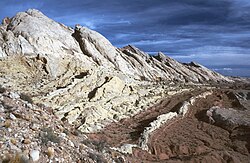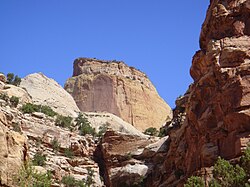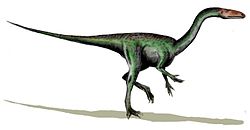Navajo Sandstone
| Navajo Sandstone | |
|---|---|
| Stratigraphic range: Hettangian-Sinemurian ~ | |
 A prominent cuesta of Navajo Sandstone rims the edge of the San Rafael Swell in eastern Utah | |
| Type | Geological formation |
| Unit of | Glen Canyon Group |
| Underlies | Carmel Formation and Page and Temple Cap sandstones, separated by J-1 and J-2 unconformities |
| Overlies | Kayenta Formation with conformable and interfingering contact |
| Thickness | Up to 2,300 ft (700 m) |
| Lithology | |
| Primary | Eolian sandstone |
| Other | Lacustrine limestone and dolomite |
| Location | |
| Coordinates | 36°42′N 110°48′W / 36.7°N 110.8°W |
| Approximate paleocoordinates | 23°54′N 48°30′W / 23.9°N 48.5°W |
| Region | Arizona, Colorado, Nevada, Utah |
| Country | United States of America |
| Extent | 102,300 sq mi (264,955.8 km2) - original extent of the Navajo Sand Sea may have been 2.5 times larger than this remaining outcrop |
| Type section | |
| Named for | Navajo County |
| Named by | Gregory and Stone[1] |
| Year defined | 1917 |
The Navajo Sandstone is a geological formation in the Glen Canyon Group that is spread across the U.S. states of southern Nevada, northern Arizona, northwest Colorado, and Utah as part of the Colorado Plateau province of the United States.[2]
Description
[edit]
The Navajo Sandstone is particularly prominent in southern Utah, where it forms the main attractions of a number of national parks and monuments including Arches National Park, Zion National Park, Capitol Reef National Park, Canyonlands National Park,[3] Glen Canyon National Recreation Area,[4] and Grand Staircase–Escalante National Monument.
Navajo Sandstone frequently overlies and interfingers with the Kayenta Formation of the Glen Canyon Group. Together, these formations can result in immense vertical cliffs of up to 2,200 feet (670 m). Atop the cliffs, Navajo Sandstone often appears as massive rounded domes and bluffs that are generally white in color.
Appearance and provenance
[edit]

Navajo Sandstone frequently occurs as spectacular cliffs, cuestas, domes, and bluffs rising from the desert floor. It can be distinguished from adjacent Jurassic sandstones by its white to light pink color, meter-scale cross-bedding, and distinctive rounded weathering.
The wide range of colors exhibited by the Navajo Sandstone reflect a long history of alteration by groundwater and other subsurface fluids over the last 190 million years. The different colors, except for white, are caused by the presence of varying mixtures and amounts of hematite, goethite, and limonite filling the pore space within the quartz sand comprising the Navajo Sandstone. The iron in these strata originally arrived via the erosion of iron-bearing silicate minerals.
Initially, this iron accumulated as iron-oxide coatings, which formed slowly after the sand had been deposited. Later, after having been deeply buried, reducing fluids composed of water and hydrocarbons flowed through the thick red sand which once comprised the Navajo Sandstone. The dissolution of the iron coatings by the reducing fluids bleached large volumes of the Navajo Sandstone a brilliant white. Reducing fluids transported the iron in solution until they mixed with oxidizing groundwater. Where the oxidizing and reducing fluids mixed, the iron precipitated within the Navajo Sandstone.
Depending on local variations within the permeability, porosity, fracturing, and other inherent rock properties of the sandstone, varying mixtures of hematite, goethite, and limonite precipitated within spaces between quartz grains. Variations in the type and proportions of precipitated iron oxides resulted in the different black, brown, crimson, vermillion, orange, salmon, peach, pink, gold, and yellow colors of the Navajo Sandstone.
The precipitation of iron oxides also formed laminae, corrugated layers, columns, and pipes of ironstone within the Navajo Sandstone. Being harder and more resistant to erosion than the surrounding sandstone, the ironstone weathered out as ledges, walls, fins, "flags", towers, and other minor features, which stick out and above the local landscape in unusual shapes.[5][6]
Age and history of investigation
[edit]The age of the Navajo Sandstone is somewhat controversial. It may originate from the Late Triassic but is at least as young as the Early Jurassic stages Pliensbachian and Toarcian.[2] There is no type locality of the name. It was simply named for the 'Navajo Country' of the southwestern United States.[7] The two major subunits of the Navajo are the Lamb Point Tongue (Kanab area) and the Shurtz Sandstone Tongue (Cedar City area).[8]
The Navajo Sandstone was originally named as the uppermost formation of the La Plata Group by Gregory and Stone in 1917.[7] Baker reassigned it as the upper formation of Glen Canyon Group in 1936.[9] Its age was modified by Lewis and others in 1961.[10] The name was originally not used in northwest Colorado and northeast Utah, where the name 'Glen Canyon Sandstone' was preferred.[11]
A 2019 radioisotopic analysis suggests that the Navajo Sandstone formation dates to the early Jurassic and began around 200-195 million years ago.[12] Kevin Padian stated in 1989 that the Navajo Sandstone extended into the Toarcian Stage.[13]
Depositional environment
[edit]The sandstone was deposited in an arid erg on the Western portion of the Supercontinent Pangaea. This region was affected by annual monsoons that came about each winter when cooler winds and wind reversal occurred.
Outcrop localities
[edit]
Navajo Sandstone outcrops are found in these geologic locations:
- Colorado Plateau
- Black Mesa Basin
- Great Basin province
- Paradox Basin
- Piceance Basin
- Plateau Sedimentary Province
- San Juan Basin
- Uinta Basin
- Uinta Uplift
- Uncompaghre Uplift
The formation is also found in these parklands (incomplete list):
- Glen Canyon National Recreation Area
- Grand Staircase–Escalante National Monument
- Zion National Park
- Canyonlands National Park
- Capitol Reef National Park
- Arches National Park
- Dinosaur National Monument
- Navajo National Monument
- Colorado National Monument
- Coral Pink Sand Dunes State Park, Kanab, Utah
Vertebrate paleofauna
[edit]Ornithodires
[edit]Indeterminate theropod remains geographically located in Arizona, USA.[14] Theropod tracks are geographically located in Arizona, Colorado, and Utah, USA.[14] Ornithischian tracks located in Arizona, USA.[14]
Color key
| Notes Uncertain or tentative taxa are in small text; |
| Ornithodires of the Navajo Sandstone | ||||||
|---|---|---|---|---|---|---|
| Genus | Species | Location | Stratigraphic position | Material | Notes | Images |
| Ammosaurus cf. major[14] |
|    | ||||
| D. wetherilli[15] |
| Attributed trackways at Red Fleet State Park.[15] | ||||
| S. halli[14] |
| "Partial postcranial skeleton." | ||||
| S. ruessi[17] |
| |||||
Iron oxide concretions
[edit]



The Navajo Sandstone is also well known among rockhounds for its hundreds of thousands of iron oxide concretions. Informally, they are called "Moqui marbles" and are believed to represent an extension of Hopi Native American traditions regarding ancestor worship ("moqui" translates to "the dead" in the Hopi language). Thousands of these concretions weather out of outcrops of the Navajo Sandstone within south-central and southeastern Utah within an area extending from Zion National Park eastward to Arches and Canyonland national parks. They are quite abundant within Grand Staircase–Escalante National Monument.[5][6]
The iron oxide concretions found in the Navajo Sandstone exhibit a wide variety of sizes and shapes. Their shape ranges from spheres to discs; buttons; spiked balls; cylindrical hollow pipe-like forms; and other odd shapes. Although many of these concretions are fused together like soap bubbles, many more also occur as isolated concretions, which range in diameter from the size of peas to baseballs. The surface of these spherical concretions can range from being very rough to quite smooth. Some of the concretions are grooved spheres with ridges around their circumference.[5][6]
The abundant concretions found in the Navajo Sandstone consist of sandstone cemented together by hematite (Fe2O3), and goethite (FeOOH). The iron forming these concretions came from the breakdown of iron-bearing silicate minerals by weathering to form iron oxide coatings on other grains. During later diagenesis of the Navajo Sandstone while deeply buried, reducing fluids, likely hydrocarbons, dissolved these coatings. When the reducing fluids containing dissolved iron mixed with oxidizing groundwater, they and the dissolved iron were oxidized. This caused the iron to precipitate out as hematite and goethite to form the innumerable concretions found in the Navajo Sandstone. Evidence suggests that microbial metabolism may have contributed to the formation of some of these concretions.[18] These concretions are regarded as terrestrial analogues of the hematite spherules, called alternately Martian "blueberries" or more technically Martian spherules, which the Opportunity rover found at Meridiani Planum on Mars.[5][6]
See also
[edit]- List of fossiliferous stratigraphic units in Utah
- Toarcian turnover
- Toarcian formations
- Marne di Monte Serrone, Italy
- Calcare di Sogno, Italy
- Sachrang Formation, Austria
- Posidonia Shale, Lagerstätte in Germany
- Ciechocinek Formation, Germany and Poland
- Krempachy Marl Formation, Poland and Slovakia
- Lava Formation, Lithuania
- Azilal Group, North Africa
- Whitby Mudstone, England
- Fernie Formation, Alberta and British Columbia
- Whiteaves Formation, British Columbia
- Los Molles Formation, Argentina
- Mawson Formation, Antarctica
- Kandreho Formation, Madagascar
- Kota Formation, India
- Cattamarra Coal Measures, Australia
References
[edit]- ^ Gregory, HE (1917), Geology of the Navajo country; a reconnaissance of parts of Arizona, New Mexico, and Utah (PDF), doi:10.3133/PP93, Wikidata Q61049764
- ^ a b Anonymous (2011b) Navajo Sandstone Archived 2006-09-23 at the Wayback Machine, Stratigraphy of the Parks of the Colorado Plateau Archived 2010-12-24 at the Wayback Machine. U.S. Geological Survey, Reston, Virginia. last accessed August 18, 2013
- ^ "The age of Utah's Navajo Sandstone - @theU". attheu.utah.edu. 2019-09-20. Retrieved 2024-12-08.
- ^ "Navajo Sandstone - Canyonlands National Park (U.S. National Park Service)". www.nps.gov. Retrieved 2024-12-08.
- ^ a b c d Chan, MA, and WT Parry (2002) Mysteries of Sandstone Colors and Concretions in Colorado Plateau Canyon Country. PDF version, 468 KB Archived 2013-08-27 at the Wayback Machine Public Information Series no. 77. Utah Geological Survey, Salt Lake City, Utah.
- ^ a b c d Chan, M., BB Beitler, WT Parry, J Ormo, and G Komatsu (2005) Red Rock and Red Planet Diagenesis: Comparison of Earth and Mars Concretions. PDF version, 3.4 MB. GSA Today. vol. 15, no. 8, pp. 4–10.
- ^ a b Gregory, Herbert Ernest (1917). Geology of the Navajo Country: A Reconnaissance of Parts of Arizona, New Mexico and Utah. U.S. Government Printing Office. pp. 23–31. ISBN 978-0341722533. Retrieved 8 April 2021.
{{cite book}}: ISBN / Date incompatibility (help) - ^ Averitt, P and RF Wilson, JS Detterman, JW Harshbarger, CA Repenning (1955) Revisions in correlation and nomenclature of Triassic and Jurassic formations in southwestern Utah and northern Arizona. American Association of Petroleum Geologists Bulletin. 39(12):2515–2524.
- ^ Baker, AA (1936) Geology of the Monument Valley-Navajo Mountain region, San Juan County, Utah. Bulletin no. 865. U.S. Geological Survey, Reston, Virginia. 106 pp.
- ^ Lewis, GE, JH Irwin, and RF Wilson (1961) Age of the Glen Canyon Group (Triassic and Jurassic) on the Colorado Plateau. Geological Society of America Bulletin. 72(9):1437–1440.
- ^ Poole, FG, and JH Stewart (1964) Chinle Formation and Glen Canyon Sandstone in northeastern Utah and northwestern Colorado. In Geological Survey research 1964. Professional Paper, no. 501-D, pp. D30-D39, U.S. Geological Survey, Reston, Virginia.
- ^ Judith Totman Parrish, E. Troy Rasbury, Marjorie A. Chan & Stephen T. Hasiotis (2019) Earliest Jurassic U-Pb ages from carbonate deposits in the Navajo Sandstone, southeastern Utah, USA. Geology 47(11): 1015-1019.
- ^ Padian, K (1989) Presence of dinosaur Scelidosaurus indicates Jurassic age for the Kayenta Formation (Glen Canyon Group, northern Arizona). Geology. 17(5):438-441.
- ^ a b c d e f g h i Weishampel, DB, P Dodson, and H Osmólska, Halszka (2007) The Dinosauria, 2nd, Berkeley: University of California Press. 861 pp. ISBN 0-520-24209-2.
- ^ a b c d Gillman, Andrew Dash. "Following the Dinosaur Tracks of Red Fleet State Park". Visit Utah. Retrieved 21 February 2018.
- ^ Lockley, M, JD Harris, and L Mitchell (2008) A global overview of pterosaur ichnology: tracksite distribution in space and time. Zitteliana. B28:187-198.
- ^ a b c Sertich, JJW and M Loewen (2010) A new basal sauropodomorph dinosaur from the Lower Jurassic Navajo Sandstone of southern Utah. PLoS ONE. 5(3)
- ^ Weber, WA, TL Spanbauer, D Wacey, MR Kilburn, DB Loope, and RM Kettler (2012) Biosignatures link microorganisms to iron mineralization in a paleoaquifer. Geology. 40(8):747–750.
Further reading
[edit]General
[edit]- Anonymous (2011a) Navajo Sandstone (in Glen Canyon Group) Archived 2013-03-08 at the Wayback Machine Capitol Reef National Park: Geological Overview. STAR: Sedimentary & Terrestrial Analog Research group, Department of Geology & Geophysics, University of Utah, Salt Lake City, Utah. last accessed August 18, 2013
- Anonymous (2011b) Navajo Sandstone, Stratigraphy of the Parks of the Colorado Plateau. U.S. Geological Survey, Reston, Virginia. last accessed August 18, 2013
- Beitler, B.; Chan, M.A.; Parry, W.T. (2003). "Bleaching of Jurassic Navajo Sandstone on Colorado Plateau Laramide highs: Evidence of exhumed hydrocarbon supergiants?". Geology. 31 (12): 1041. Bibcode:2003Geo....31.1041B. doi:10.1130/G19794.1. ISSN 0091-7613. Wikidata Q73323225.
- Elder, J. (2005) Hele-Shaw Cell: Avalanche Segregation and Stratification. Utah Sand, Ottawa, Canada. last accessed August 18, 2013
- Loope, D.B. (nda) Photos - Navajo Sandstone trace fossils. Dr. David B. Loope – Sedimentology and Stratigraphy, Department of Earth and Atmospheric Sciences, University of Wyoming, Laramie, Wyoming. last accessed August 18, 2013
- Loope, D.B. (ndb) Photos - Navajo Sandstone- Rain-Induced Slumps. Dr. David B. Loope – Sedimentology and Stratigraphy, Department of Earth and Atmospheric Sciences, University of Wyoming, Laramie, Wyoming. last accessed August 18, 2013
- Loope, D.B. (ndc) Dry-Season Dinosaur Tracks in the Navajo Sandstone. PDF Version (3.9 MB) poster. Dr. David B. Loope – Sedimentology and Stratigraphy, Department of Earth and Atmospheric Sciences, University of Wyoming, Laramie, Wyoming. last accessed August 18, 2013
- Ostapuk, P., (nd) Navajo Sandstone Fossils. Glen Canyon Natural History Association Archived 2013-04-12 at the Wayback Machine, Page, Arizona. last accessed August 18, 2013
- Peters, P.E., and N.A. Heim (nd) Navajo Sandstone Formation - Glen Canyon Group: Spatial Distribution in Macrostrat. Macrostrat Beta 0.3, Department of Geoscience, University of Wisconsin-Madison, Madison, Wisconsin. last accessed August 18, 2013
- Pratt, S.. (2003) Tracing the Navajo sandstone. Geotimes. (November 2003). last accessed August 18, 2013
- Stamm, N. (2013) Geologic Unit: Navajo Sandstone., National Geologic Database. U.S. Geological Survey, Reston, Virginia. last accessed August 18, 2013
- Vendetti, J. (2001) Jurassic monsoons. Geotimes. (September 2001). last accessed August 18, 2013
Scientific publications
[edit]- Chan, M.A., and A.W. Archer (2000) Cyclic Eolian Stratification on the Jurassic Navajo Sandstone, Zion National Park: Periodicities and Implications for Paleoclimate PDF version, 3.2 MB Archived 2016-04-21 at the Wayback Machine. in D.A. Sprinkel, T.C. Chidsey, Jr., and P.B. Anderson, eds., Geology of Utah's Parks and Monuments. Utah Geological Association Publication 28:1-11. last accessed August 18, 2013
- Kocurek G. 2003. Limits on extreme Eolian systems: Sahara of Mauritania and Jurassic Navajo Sandstone examples. in M. Chan and A. Archer, eds., Extreme Depositional Environments: Mega End Members in Geologic Time. Geological Society of America Special Paper 370:43-52. last accessed August 18, 2013
- Loope, D.B., and C.M. Rowe (2003) Long-Lived Pluvial Episodes during Deposition of the Navajo Sandstone PDF version, 1.3 MB. The Journal of Geology 111:223-232. last accessed August 18, 2013
- Loope, D.B., and C.M. Rowe (2005) Seasonal Patterns of wind and rain recorded by the Navajo Sandstone PDF version, 7.4 MB. Canyon Legacy. 54:8-12. last accessed August 18, 2013
- Loope, D.B., and Z.C. Zanner (2005) Eolian Pin Stripes in the Navajo Sandstone. Geological Society of America Abstracts with Programs, Vol. 37, No. 7, p. 506. last accessed August 18, 2013
- Loope, D., L. Eisenberg, and E. Waiss (2004) Navajo sand sea of near-equatorial Pangea: Tropical westerlies, slumps, and giant stromatolites. in E.P. Nelson and E.A. Erslev, eds., pp. 1–13, Field Trips in the Southern Rocky Mountains, USA. GSA Field Guide no. 5, Geological Society of America, Boulder, Colorado. last accessed August 18, 2013
- Loope, D.B., C.M. Rowe, and R.M. Joeckel (2001) Annual monsoon rains recorded by Jurassic dunes PDF version, 284 KB. Nature. 412:64-66. last accessed August 18, 2013
- Loope, D.B., M.B. Steiner, C.M. Rowe, and N. Lancaster (2004) Tropical westerlies over Pangean sand seas PDF version, 340 KB. Sedimentology. 51:315-322. last accessed August 18, 2013
- Irmis, R.B. (2005) A review of the vertebrate fauna of the Lower Jurassic Navajo Sandstone in Arizona. PDF version, 2.4 MB in R.D. McCord, ed., pp. 55–71, Vertebrate Paleontology of Arizona. Mesa Southwest Museum Bulletin no. 11. Mesa Southwest Museum, Arizona Museum of Natural History, Mesa, Arizona. last accessed August 18, 2013
- Rainforth, E.C. (1997) Vertebrate ichnological diversity and census studies, Lower Jurassic Navajo Sandstone PDF version, 3.9 MB. Unpublished masters thesis, Department of Geological Sciences, University of Colorado, Boulder. last accessed August 18, 2013
- Tape, C. (2005) The Lower Jurassic Navajo Sandstone: large-scale deposition and small-scale structures, Site: Glen Canyon Dam. PDF version, 4.8 MB. in J.L. Kirschvink, ed., Field Trip to Colorado Plateau (southern Utah, northern Arizona, Permian-Triassic boundary). Division of Geological and Planetary Sciences, California Institute of Technology, University of California. last accessed August 18, 2013


 French
French Deutsch
Deutsch
